
Nancy Pelosi announced today that she is seeking a formal impeachment inquiry against President Donald Trump. The proceedings stem around allegations that he withheld Ukrainian aid while seeking to convince the Ukrainian President to investigate Joe Biden and his son. Trump has denied these allegations and is releasing a transcript of his phone call tomorrow. What would be next in the impeachment process if Congress moved forward?
A Majority Vote in the House Is Needed to Impeach Trump
The next step in the impeachment process would be a House vote after a formal inquiry. The Constitution only allows impeachment on the grounds of “Treason, Bribery, or other high Crimes and Misdemeanors.” The “high Crimes and Misdemeanors” part is vaguer and not actually defined in the Constitution.
The House typically first conducts an investigation, often by the House Judiciary Committee. Nixon’s impeachment inquiry, however, was conducted by the Senate Judiciary Committee. Sometimes the inquiry is led by an independent counsel.
Articles of impeachment are drawn up, which are essentially formal allegations against the President. The House then votes on these allegations. In order for a sitting President to be impeached, the House must pass the articles of impeachment by a simple majority.
If all 435 House members vote on the articles of impeachment, they would need 218 votes for a majority to be reached and for Trump to be impeached. There are 235 Democrats in office in the House, one Independent, and 199 Republicans, Reuters explained. That’s more than enough to reach the simple majority needed if all Democrats voted for impeachment. So far more than 150 House Democrats have spoken out supporting impeachment.
Things get more difficult after this point. The Senate will try the accused next, and the Chief Justice of the United States presides over the proceedings. Actual conviction and removal require a 2/3 vote in the Senate. This is why removal is unlikely without an egregious crime that can’t be denied. A total of 67 Senators would need to vote to convict and remove Trump. There are 45 Democrat Senators and 53 Republican Senators, plus two Independents who typically vote Democrat. So to reach the 67 total needed to remove Trump, they would need at least 20 Republicans to join with Democrats in voting to remove Trump (plus the two Independents), Reuters reported.
It’s unlikely that 20 Republican Senators would vote to remove Trump.
How This All Got Started
Political leaders are seeking to know if President Donald Trump pressured Ukrainian President Volodymyr Zelenksy into investigating Joe Biden and his family, The Washington Post reported.
The phone call where Trump is alleged to have pressured Zelensky occurred in July, The Hill reported. The allegations are that Trump pressured him to investigate Joe Biden and his son, Hunter Biden. Around this same time, Trump’s administration froze $250 million in military aid to Ukraine. Trump later released the aid.
Trump spoke with reporters at the United Nations General Assembly and said he never pressured to withdraw aid if the investigations didn’t happen. He “did not make a statement that you have to do this or I’m not going to give you aid,” he told reporters. He has now said that he plans to release an unredacted transcript of his phone call in order to prove that he did not do what he is accused of doing.
READ NEXT: Trump Impeachment Polls
